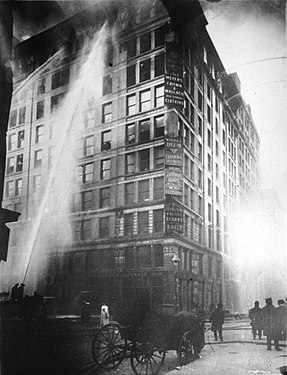General Discussion
Related: Editorials & Other Articles, Issue Forums, Alliance Forums, Region Forumstriangle shirtwaist factory fire-25 march 1911
Last edited Tue Mar 25, 2014, 07:26 PM - Edit history (1)
(disgusting to note how much the owners made from the fire, versus how little the families were "compensated"![]()
Triangle Shirtwaist Factory fire

Coordinates: 40°43′48″N 73°59′43″W
Date March 25, 1911
Time 4:40 PM (local time)
Location Manhattan, New York City, U.S.
Deaths 146
Injuries 71
The Triangle Shirtwaist Factory fire in Manhattan, New York City on March 25, 1911 was one of the deadliest industrial disasters in the history of the city, and resulted in the fourth highest loss of life from an industrial accident in U.S. history. It was also one of the deadliest disasters that occurred in New York City – after the burning of the General Slocum on June 15, 1904 – until the destruction of the World Trade Center 90 years later. The fire caused the deaths of 146 garment workers – 123 women and 23 men [1] – who died from the fire, smoke inhalation, or falling or jumping to their deaths. Most of the victims were recent Jewish and Italian immigrant women aged sixteen to twenty-three;[2][3][4] of the victims whose ages are known, the oldest victim was Providenza Panno at 43, and the youngest were 14-year-olds Kate Leone and "Sara" Rosaria Maltese.[5]
Because the owners had locked the doors to the stairwells and exits – a common practice at the time to prevent pilferage and unauthorized breaks[6] – many of the workers who could not escape the burning building jumped from the eighth, ninth, and tenth floors to the streets below. The fire led to legislation requiring improved factory safety standards and helped spur the growth of the International Ladies' Garment Workers' Union, which fought for better working conditions for sweatshop workers.
The factory was located in the Asch Building, at 23–29 Washington Place in the Greenwich Village neighborhood of Manhattan, now known as the Brown Building and part of New York University. The building has been designated a National Historic Landmark and a New York City landmark.[7]
The Triangle Waist Company[8] factory occupied the eighth, ninth, and tenth floors of the 10-story Asch Building on the northwest corner of Greene Street and Washington Place, just east of Washington Square Park, in the Greenwich Village area of New York City. Under the ownership of Max Blanck and Isaac Harris, the factory produced women's blouses, known as "shirtwaists." The factory normally employed about 500 workers, mostly young immigrant women, who worked nine hours a day on weekdays plus seven hours on Saturdays,[9] earning between $7 and $12 a week.[6]
As the workday was ending on the afternoon of Saturday, March 25, 1911, a fire flared up at approximately 4:40 PM in a scrap bin under one of the cutter's tables at the northeast corner of the eighth floor.[10] The first fire alarm was sent at 4:45 PM by a passerby on Washington Place who saw smoke coming from the eighth floor.[11] Both owners of the factory were in attendance and had invited their children to the factory on that afternoon.[12] The Fire Marshal concluded that the likely cause of the fire was the disposal of an unextinguished match or cigarette butt in the scrap bin, which held two months' worth of accumulated cuttings by the time of the fire.[13] Beneath the table in the wooden bin were hundreds of pounds of scraps which were left over from the several thousand shirtwaists that had been cut at that table. The scraps piled up from the last time the bin was emptied, coupled with the hanging fabrics that surrounded it; the steel trim was the only thing that was not highly flammable.[14] Although smoking was banned in the factory, cutters were known to sneak cigarettes, exhaling the smoke through their lapels to avoid detection.[15] A New York Times article suggested that the fire may have been started by the engines running the sewing machines, while The Insurance Monitor, a leading industry journal, suggested that the epidemic of fires among shirtwaist manufacturers was "fairly saturated with moral hazard."[12] No one suggested arson.
. . . .
http://en.wikipedia.org/wiki/Triangle_Shirtwaist_Factory_fire
HockeyMom
(14,337 posts)as a little girl. At 11 years old, and the daughter of Italian immigrants, she was almost the age of the youngest victims. She never said if she knew any of those young women, and I did not ask her. She had tears in her eyes when she told me about it.
niyad
(113,587 posts)conditions. certainly brings things into an even more personal context, and I thank you for doing so.
JHB
(37,162 posts)...a little over $3/hour to a little under $5.50/hour (naturally, no overtime).
In thew civil suit which followed, the plaintiffs won the equivalent of $1657.50 for each deceased victim (i.e., total of rough equivalent of $245,310 from the owners).
The owners received the equivalent of $1,326,000 from their insurance company. One of them was fined the equivalent of $442 for locking the exits.
And if you want to go back to that, you're probably a Republican (with a few "pro-business" Third Wayers hiding in the back row hoping no one will notice them behind all the elephants).
niyad
(113,587 posts)harris and planck made a fortune off the deaths, and it apparently never, ever bothered them.
you are correct, the pukes want to go back to that--workers as slaves, no regs, completely unfettered control and PROFITS.